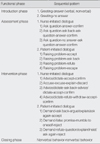Abstract
Purpose
The purpose of the study was to identify functional structure and patterns of dialogue sequence in conversations between elderly patients with dementia and nurses in a long-term care facility.
Methods
Conversation analysis was used to analyze the data which were collected using video-camera to capture non-verbal as well as verbal behaviors. Data collection was done during February 2005.
Results
Introduction, assessment, intervention, and closing phases were identified as functional structure. Essential parts of the conversation were the assessment and intervention phases. In the assessment phase three sequential patterns of nurse-initiated dialogue and four sequential patterns of patient-initiated dialogue were identified. Also four sequential patterns were identified in nurse-initiated and three in patient-initiated dialogues in the intervention phase. In general, "ask question", "advise", and "directive" were the most frequently used utterance by nurses in nurse-initiated dialogue, indicating nurses' domination of the conversation. At the same time, "ask back", "refute", "escape", or "false promise" were used often by nurses to discourage patients from talking when patients were raising questions or demanding.
Figures and Tables
References
1. Adams T. The discursive construction of dementia care: Implications for mental health nursing. Journal of Advanced Nursing. 1998. 28:614–621.
2. Atkinson M, Heritage J. Structures of social action: Studies in conversation analysis. 1984. Cambridge: Cambridge University Press.
3. Bak YI. Introduction into the dialog analysis. 2001. Seoul: Doseochoolpan Yeog Lag.
4. Caris-Verhallen WM, Kerkstra A, Bensing JM. The role of communication in nursing care for elderly people: A review of the literature. Journal of Advanced Nursing. 1997. 25:915–933.
5. Deppermann A.
Y.I Bak
. Conversation analysis. 2002. Seoul: Doseochoolpan Yeog Lag.
6. Drew P, Chatwin J, Collins S. Conversation analysis: A method for research into interactions between patients and health-care professionals. Health Expectations. 2001. 4:58–70.
7. Drew P, Heritage J, editors. Talk at work: Interaction in institutional settings. 1998. New York, NY: Cambridge University Press.
8. Giles H, Noels KA, Williams A, Ota H, Lim TS, Ng SH, et al. Intergenerational communication across cultures: Young people's perception of conversations with family elders, non-family elders and same-age peers. Journal of Cross-Cultural Gerontology. 2003. 18:1–32.
9. Hewison A. Nurses' power in interactions with patients. Journal of Advanced Nursing. 1995. 21:75–82.
10. Hutchby I, Wooffitt R. Conversation analysis. 1998. Malden, MA: Blackwell Publishers Inc.
11. Jones A. Nurses talking to patients: Exploring conversation analysis as a means of researching nurse-patient communication. International Journal of Nursing Studies. 2003. 40:609–618.
12. Kettunen T, Poskiparta M, Gerlander M. Nurse-patient power relationship: Preliminary evidence of patients' power messages. Patient Education and Counseling. 2002. 47:101–113.
13. Lee HJ. A conversational analysis about patient's discomfort between a patient with cancer and a nurse. Journal of Korean Academy of Nursing. 2007. 37:145–155.
14. Mitcheson J, Cowley S. Empowerment or control? An analysis of the extent to which client participation is enabled during health visitor/client interactions using a structured health needs assessment tool. International Journal of Nursing Studies. 2003. 40:413–426.
15. Oh JJ. The effect of hand-massage on the relaxation of dementia patients. Journal of Korean Academy of Nursing. 2000. 30:825–835.
16. Psathas G. Conversation analysis: The study of talk-in-interaction. 1995. Thousand Oaks, CA: Sage Publications.
17. Schegloff EA. Analyzing single episodes of interaction: An exercise in conversation analysis. Social Psychology Quarterly. 1987. 50:101–114.
18. Son HM. Functional phases and patterns of dialogue sequence in nurse-patient conversation about medication. Journal of Korean Academy of Nursing. 2007. 37:52–63.
19. Ten Have P. Boden D, Zimmerman DH, editors. Talk and institution: A reconsideration of the "asymmetry" of doctor-patient interaction. Talk & social structure: Studies in ethnomethodology and conversation analysis. 1991. Cambridge: Polity Press;138–165.
20. Yi M. Secondary analysis of qualitative data: Methodological issues and implications. Journal of Nursing Query. 2003. 12:82–96.
21. Yi M. Secondary analysis: Focusing on qualitative research. Journal of Korean Academy of Nursing. 2004. 34:35–44.
22. Yi M. Conversation analysis for improving nursing communication. Journal of Korean Academy of Nursing. 2007. 37:772–780.
23. Yi M, Yih BS. A conversation analysis of communication between patients with dementia and their professional nurses. Journal of Korean Academy Nursing. 2006. 36:1253–1264.




 PDF
PDF ePub
ePub Citation
Citation Print
Print



 XML Download
XML Download